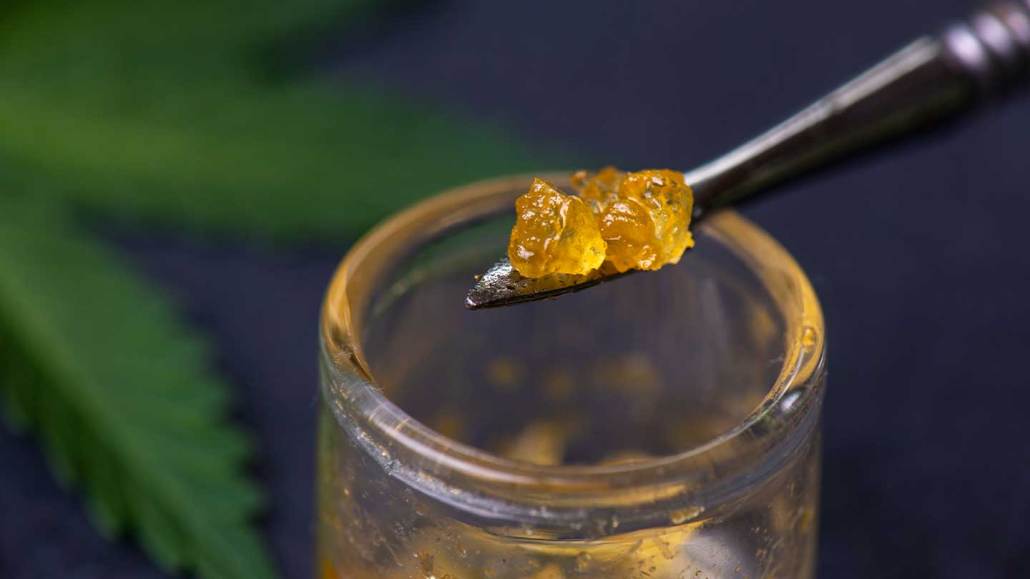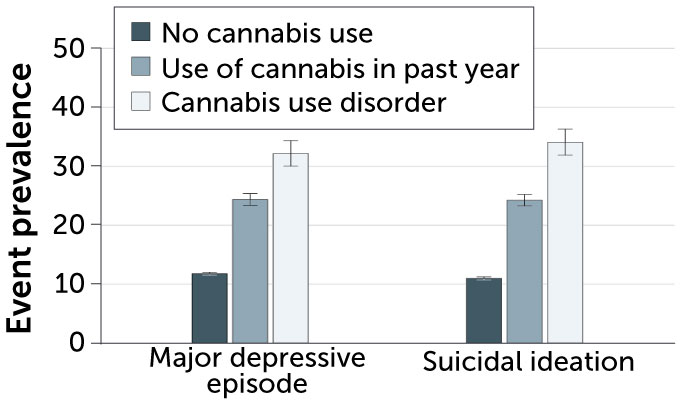The teen brain is especially susceptible to the harms of THC
The amount of THC in cannabis plants is much higher than 30 years ago

Concentrated cannabis products, produced by extracting cannabinoids from the plant, can have a THC potency as high as 95 percent.
rgbspace/iStock/Getty Images Plus
Ask thousands of teens whether frequent use of certain substances brings a high risk of harm, and they mostly nail it: a majority say yes for cigarettes, alcohol, cocaine and heroin. But there’s one substance that many skip over — cannabis.
Only 35 percent of 12- to 17-year-olds perceive a “great risk of harm” from smoking marijuana once or twice a week, according to the National Survey on Drug Use and Health.
It’s a sentiment that some of their parents may share. Parents often don’t understand that the products used today “are not what they knew when they were in high school,” says Kelly Young-Wolff, a licensed clinical psychologist and research scientist at Kaiser Permanente Northern California Division of Research in Oakland. If their children are using cannabis, parents may think, “‘it’s not that bad, at least they’re not using this other drug that’s worse.’”
But the cannabis products available now are leaps and bounds more potent — which may increase the risks for addiction and psychosis — than in the past. Marijuana plants have been bred to contain more delta-9-tetrahydrocannabinol, or THC, the main psychoactive chemical. In 1995, the total percent of THC by weight of marijuana plant material was around 4 percent; now marijuana with a THC potency of 20 percent or more is available. Trouncing that are concentrated cannabis products, including wax, budder and shatter, which can have a THC potency as high as 95 percent.
Cannabis is legal for adults to use recreationally in 24 states and Washington, D.C., and is allowed for medical use in 38 states and D.C. The widespread availability of cannabis “promotes the idea that it’s safe,” says pediatrician Beth Ebel of the University of Washington School of Medicine and Seattle Children’s Hospital. But that “is an incorrect assumption.” THC can impact brain chemistry “in a way that wasn’t intended,” Ebel says. “Some of the worst effects can have lifelong health consequences, especially for a young person.”
Concentrated cannabis products can be so extremely potent, and so different from what’s been known as cannabis, that “we need to start calling them something else,” says neuroscientist Yasmin Hurd of the Icahn School of Medicine at Mount Sinai in New York City. “These are new drugs.”
How does THC affect the adolescent brain?
As is true for other drugs, adolescence is an especially risky time to use cannabis. “The adolescent brain is still developing into early adulthood,” Hurd says. During this period, connections within adolescents’ brains are forming, getting reinforced or being pruned. “Your brain is trying to figure out, ‘what is important that I need to learn, and what is important that I need to retain,’” Ebel says, and this process is “negatively affected by THC.”
THC binds to one of the main receptors, called CB1, of the endocannabinoid system. This complex system influences many functions in the body. In the brain, the endocannabinoid system plays a crucial role in the organ’s development and helps to regulate anxiety, pain, memory, the motivation of behaviors and more.
The endocannabinoid system also contributes to structural changes that occur as developing teen brains mature. But THC can interfere with the system’s signaling during this key time and leave an imprint on the brain’s structure.
Studies in animals have found that exposure to THC in adolescence can reduce CB1 receptors in the brain and lead to long-lasting problems with memory and learning. One of the areas the psychoactive chemical alters is the prefrontal cortex, which matures during adolescence and is integral to problem-solving and emotional regulation. In adolescent rats injected with THC, nerve cell protrusions that connect with other nerve cells were prematurely cut back, disrupting the circuitry of the prefrontal cortex, Hurd and colleagues reported in Molecular Psychiatry in 2019.
There’s also evidence in people that THC changes teens’ brains. Researchers analyzed close to 1,600 magnetic resonance images of the brains of nearly 800 adolescents, taken at 14 and 19 years of age, on average. There was an association between cannabis use over the five years and an accelerated thinning of the prefrontal cortex, the researchers reported in JAMA Psychiatry in 2021. Cortical thinning is expected in adolescence and is likely tied to the pruning of underused connections. But accelerated thinning means that process isn’t following the normal developmental plan. The researchers hypothesize that the accelerated thinning might be connected to the premature loss of nerve cell protrusions that was described in the rat study.
Marijuana use is linked to mental health harms
Using cannabis puts teens’ mental health at risk. That’s true even for someone using cannabis recreationally. Adolescents ages 12 to 17 whose cannabis use did not meet the threshold for a substance use disorder were about twice as likely to develop depression or have suicidal ideation as those who didn’t use cannabis, according to a study of more than 68,000 adolescents published in May in JAMA Network Open.
The risks increase for those with cannabis use disorder, which is diagnosed when someone’s use interferes with daily life, but they aren’t able to stop using, among other symptoms. The JAMA Network Open study reported that adolescents with cannabis use disorder were 2.5 and 3 times as likely to have depression or suicidal ideation, respectively, as those who didn’t use cannabis.
Cannabis and mental health
Adolescents who met the diagnosis for cannabis use disorder or who used the drug recreationally had a higher prevalence of depression and suicidal ideation than those who didn’t use cannabis.
Prevalence of mental health events in adolescents by cannabis use

Beginning cannabis use as a teen is more likely to lead to dependence than starting as an adult, just like alcohol, cocaine and nicotine. Compared with young adults, adolescents are more susceptible to dependence within a year of taking up marijuana. Eleven percent of those ages 12 to 17 progressed to cannabis use disorder by 12 months, but only 6 percent of those ages 18 to 25 did, researchers reported in 2021 in JAMA Pediatrics. After three years, the prevalence was 20 percent of adolescents versus 11 percent of young adults.
Yet many teens are turning to marijuana as a coping mechanism. A study of what motivated high school seniors to use cannabis found that reasons related to coping — such as to escape problems, relieve tension or deal with anger — approximately doubled in prevalence during the last four decades, researchers reported in 2019 the Journal of Studies on Alcohol and Drugs. For a project on how cannabis legalization for adults in California has impacted adolescent health, Young-Wolff has talked to clinicians who care for adolescents. They’ve told her that many of their patients who use cannabis are doing so to self-medicate, to try to relieve symptoms of depression or anxiety.
Ebel has seen this too. But as the drug wears off, users are more anxious than they were before, she says. “It drives a cycle that drives increased use.”
When marijuana is a part of a teen’s everyday life, it can change their future trajectory. A study of young people in Australia and New Zealand compared the frequency of cannabis use before the age of 17 with how participants had fared by age 30. Those who used cannabis daily were more likely to become dependent on cannabis, use other drugs and attempt suicide, and less likely to finish high school, compared with teens who had never used, researchers reported in 2014 in the Lancet Psychiatry.
Cannabis addiction is also tied to the development of the psychiatric disorder schizophrenia. A study of nearly 7 million Danish people ages 16 to 49 found an association between cannabis use disorder and schizophrenia, researchers reported in May in Psychological Medicine. The association was stronger for males overall and especially at the ages of 16 to 25 years old. The researchers estimate that in 2021, without cannabis use disorder, around 15 percent of cases of schizophrenia in males and 4 percent in females would not have occurred.
The risks of using concentrated cannabis products
Although smoking the marijuana plant is still the most common way teens use cannabis, vaping cannabis concentrates is on the rise. A study of high school seniors reported that from 2015 to 2018, among past-year cannabis users, smoking decreased from 95 percent to 90 percent, while vaping increased from 26 percent to 34 percent. Daily use was also more common among those who vaped, at 29 percent, verses those who smoked, at 18 percent, researchers reported in JAMA Pediatrics in 2020.
There is early evidence that high-potency products are associated with an increased risk of psychosis, a symptom of schizophrenia. In a study of adults, daily use of high-potency cannabis products led to nearly five times the risk of psychosis compared with people who didn’t use cannabis, researchers reported in 2019 in Lancet Psychiatry. For the purposes of the study, high potency was defined as having 10 percent THC or higher.
There are also reports of a rise in cannabis hyperemesis syndrome, a complication of high potency cannabis use that leads to abdominal pain, nausea and repeated vomiting. A Canadian study found that emergency department visits for the syndrome increased 13-fold from 2014 to 2021.
Ebel says concentrated cannabis products are largely unstudied and “pose new and alarming health risks.” Hurd says that because we don’t know the full impact on health from high potency products, users are essentially the test subjects.
So as with other substances, public health officials recommend that parents talk with their kids about the risks of cannabis use. Especially with indications that teens are turning to cannabis to self-medicate, “if you notice a change in your child’s behavior, try to find out what’s going on,” Young-Wolff says. It’s also important for parents to consider the messages they send about marijuana, she says. The clinicians Young-Wolff has talked to have noticed that parents are using cannabis more and that they’ve become more permissive about teen cannabis use. “That can really make it hard to get this message to the kids to not use,” she says.
So, for adults who are taking part in the new legality of marijuana: “If you are going to use cannabis,” Young-Wolff says, “don’t use in front of your children.”







